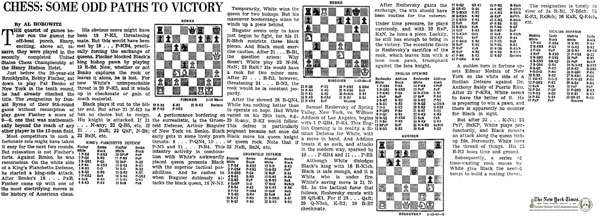New York Times, New York, New York, Sunday, January 12, 1964 - Page 376
Chess: Some Odd Paths To Victory
The quartet of games below run the gamut for off-beat punch. Sharp, exciting, above all, bizarre, they were played in the recently completed United States Chess Championship at the Henry Hudson Hotel.
Just before the 20-year-old Brooklynite, Bobby Fischer, sat down to play Pal Benko of New York in the tenth round, he had already clinched the title. The resignation by Donald Byrne of their 9th round game without resumption of play gave Fischer a score of 9—0, one that was mathematically beyond the reach of any other player in the 12-man field.
Most competitors in such a fortunate role might have taken it easy for the next two rounds. But relaxation is not Fischer's forte. Against Benko, he was remorseless. On the white side of a King's Fianchetto Defense, he started a king-side attack. After Benko's 18… PxB, Fischer came up with one of the most electrifying moves in the history of American chess.
His obvious move might have been 19 P-K5, threatening mate. But this would have been met by 19 … P-KB4, practically forcing the exchange of queens. Fischer blocked Black's king bishop pawn by playing 19 R-B6. Now, whether or not Benko captures the rook or leaves it alone, he is lost. For now White's unimpeachable threat is 20 P-K5, and it winds up in checkmate or gain of much material.
Black plays it out to the bitter end. But after 21 N-K2 he has no choice but to resign. His knight is attacked. If 21 … N-any; 22 Q-B5, etc. If 21 … BxR; 22 QxP, N-B4; 23 BxN, etc.























